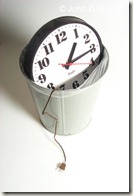Note
Access to this page requires authorization. You can try signing in or changing directories.
Access to this page requires authorization. You can try changing directories.
(Note: See this is the third and final post in the series. See these links for SSD Odyssey, Part 1 and SSD Odyssey, Part 2)
I started this series with the quest for “Extreme Windows 7 Speed”. With the results of the clean install, I knew I was on the right track. Sure, there are faster desktops out there, and probably faster laptops. But for a corporate approved, “IT Standard” laptop, the ability to boot all the way to a fully loaded MSN page in 34 seconds is pretty exceptional. Especially, given the BIOS took 10 of those seconds and I logged in and launched IE8 manually.
But these results were with a clean install of Windows 7. What would happen if I paired this “IT standard” laptop with an “IT standard” Windows 7 Enterprise image, complete with security software, Office 2010 beta, and all my other apps and data? In other words, what would the *real* experience be?
To find out, I had to get the my existing system image onto the new disk. After running into an issue I never truly understood trying to restore the system image from the Windows Recovery Environment using the disc I created, I decided to try the Acronis True Image Home 2010.
Trials, Tribulations, and Resolutions
There is a free version of this software that works for 30 days, so I downloaded and installed that on a separate machine. Turns out Acronis True Image can work with VHD files created by Windows, as well as it’s own proprietary format for system images. Since I had already created the system image VHD with Windows 7, my first attempt was to restore this VHD using the Acronis software. Similar to creating the Windows 7 Recovery Environment, using Acronis to load up a system image onto a new disk requires creating an Acronis boot disk to access their utility without loading Windows from the installed drive. I re-installed the original HDD, created the Acronis boot disk, and then re-installed the SSD. All worked as expected. After about 45 minutes or so of this and that, I booted the new HP into the Acronis True Image utility.
I found the VHD on my external USB drive without a hitch, and tried to restore it onto the SSD. It was then that I realized this feature is not available in the free product from Acronis. If I read the documentation correctly it looks like you can restore between 2 installed drives, but not from an external USB drive. Grrrr. I didn’t feel too bad about coughing up the extra $50 for the Acronis software as it looks like a good product with additional features I’ll probably use. And, I didn’t need to re-install the product – just get an activiation code, so that didn’t take too long. Unfortunately, I did need to recreate the boot disk utility, which also meant swapping the original HDD back in again, and then back out again. It was starting to get late.
About 40 minutes after I booted into the Acronis utility for the first time, I did so again. This time, using a fully licensed and fully functional version of the software. I quickly found the VHD on my external drive again, and configured the Acronis software to restore it to my SSD.
 After churning for about 30 minutes or so, my machine was ready. I rebooted to load Windows 7, and… got a nice little error message that said Windows could not be loaded, and advising me to insert my recovery disk. Since I had already tried restoring the VHD from the Windows Recovery Environment, I decided to ignore the error and create a new system image using the Acronis utility. Out went the SSD again, and in went the original Hitachi HDD (again).
After churning for about 30 minutes or so, my machine was ready. I rebooted to load Windows 7, and… got a nice little error message that said Windows could not be loaded, and advising me to insert my recovery disk. Since I had already tried restoring the VHD from the Windows Recovery Environment, I decided to ignore the error and create a new system image using the Acronis utility. Out went the SSD again, and in went the original Hitachi HDD (again).
As I was exploring the Acronis utility to learn how to create the system image, I noticed a menu option for disk cloning. Whereas a system image creates a single large file that the restore software can use to make an exact replica of your data onto a new disk, cloning is a sector by sector copy of disk data from one disk to another. There is no restore process. I decided to give the disk cloning a go, and configured Acronis to create a clone of the original Hitachi disk onto my external USB drive. All told, this took another 45 minutes or so.
Then, I swapped out the Hitachi HDD, hopefully for the last time, and re-installed the OCZ Vertex SSD. I booted with the Acronis utility disc, and then configured Acronis to clone the external USB drive to the SSD. This ran for about 30 minutes. When it was done, I held my breath and rebooted. Error. Ugh. It was now almost 4:00am, the Wednesday before Thanksgiving. This was not going as expected. The error advised me to insert my Windows Recovery disc. I could try to create a System Image with the Acronis utility – something I had not done yet, but this would mean yet again swapping the SSD out, running the utility, and re-installing the drive, and running the restore utility a second time. Having already spent most of the night doing this, I knew it would be 90 minutes before I could even try booting again. If all went well, I would still not get to bed until 5:30 or 6:00am. Not good.
I went ahead and did as the error message suggested: I put in the Windows Recovery Environment disc. I had no expectations of success, but I knew the alternative was another 90 minutes of work and I really didn’t want that.
 To my amazement, the Windows Recovery Environment automatically detected and fixed whatever was wrong with my load. Not only that, but it found 2 Windows operating systems! I think what might have happened is that I had cloned only the used sectors of my Hitatchi drive, and when Acronis wrote those sectors to the SSD it used empty sectors – leaving the VHD restore already there intact (or at least some of it)?
To my amazement, the Windows Recovery Environment automatically detected and fixed whatever was wrong with my load. Not only that, but it found 2 Windows operating systems! I think what might have happened is that I had cloned only the used sectors of my Hitatchi drive, and when Acronis wrote those sectors to the SSD it used empty sectors – leaving the VHD restore already there intact (or at least some of it)?
In any case, with a re-start, Windows 7 booted just fine and all my apps and data were exactly as I left them, with one exception: Office 2010 beta told me it needed to be activated in the next 30 days. I could definitely live with that for the time being.
I’m not sure, of course, but maybe if I had followed the advice of the original error message I would have been done hours before. Doh!
What did I learn?
After all of this, my simple advice to someone setting up a new SSD would be as follows:
- Try using the Windows Create System Image utility and the restore from the Windows Recovery Environment disc. If you get an error message upon trying to boot that tells you to re-boot with the Windows Recovery Environment disc, do it. :)
- If that doesn’t work, buy Acronis True Image Home 2010, use the disk cloning feature, and keep that Windows Recovery Environment boot disk handy.
Now that I have a real world, “IT standard” Windows 7 image running with security software, as well as all my apps and data, the overall experience is still very good. Is it totally awesome? Not quite. Some part of the slower experience is probably due to all the extra stuff that is loaded. And I suspect some part may partly be because I have written a lot of data onto this drive, copying things back and forth. Sure, the TRIM command is supposed to help with this… and according to this awesome article by AnandTech it does… but it’s still not quite the same experience as a brand new drive. This just an inherent part of the MLC architecture used in every 120 GB+ SSD that fits into my budget.
Performance Results
So what are my real world results for common tasks like boot times, loading MSN, loading outlook, etc? See table below for comparisons overall system performance between the original Hitachi 7200 RPM drive and the OCZ SSD.
| Hitachi 7200 RPM 250 GB | OCZ Vertex 128GB | |
| Windows Experience Index | 5.4 (Disk: 5.4) | 6.3 (Disk: 7.2) |
| Boot to login prompt | 37 sec | 34 sec |
| Boot to desktop (auto-loading Live Messenger, Live Mesh) | 67 sec (+30) | 56 sec (+22) |
| Boot to MSN page in IE8 | 75 sec (+8) | 60 seconds (+4) |
| Boot to Outlook 2010 beta (huge inbox, lots of add-ins) | 90 sec (+15) | 66 seconds (+6) |
Ultimately, did I succeed in my quest for Windows 7 Extreme Speed in real world usage? No. Am I happy with the OCZ Vertex purchase at $499? Sort of. I’m happy with the drive, but not the price. Would I buy it again? Yes (but I would get it here for less). Would I go back to a rotating HDD? Not on your life.
Finally, if you’re in the market for an SSD, here are some resources I recommend you check out:
- E7 Blog (Engineering Windows 7) – Windows 7 Support for SSDs, including overview of TRIM command and support in Windows 7
- Tom’s Guide – Upgrading to an SSD
- Tom’s Hardware – Review of Intel X-25M
- AnandTech – How SSDs work
- SSD overview – Wikipedia – Wikipedia version of what SSDs are and how they work
- Disk Cloning overview – Wikipedia – How disk cloning works, history of disk cloning, as well as links to other Wikipedia articles listing different disk cloning software utilities and comparing features of different disk cloning software utilities
- OCZ Forums for SSD – The place for answers OCZ and community support for OCZ SSDs
- Freddy’s Blog – Performance benefit from running Dynamics NAV on a SSD
- Christophe Fiessinger's Blog - Performance benefit from running SharePoint, Project Server VHDs on a SSD
Technorati Tags: SSD,Windows 7 Speed
Comments
Anonymous
December 06, 2009
Instead of Acronis, which often seems to be troublesome for many, I use the Partition Management utility in BootitNG and copy the partition from disc to disc. To avoid cloning to a 3d drive and then copying again, get a USB-SATA/IDE adapter kit (the Rosewill RCW-608 worked fine for me) and put one of the two drives in it and do a direct copy once... and you're done.Anonymous
December 06, 2009
Thanks George! The USB-SATA/IDE adapter kit sounds like just what I needed!